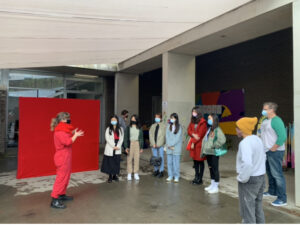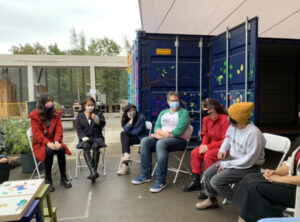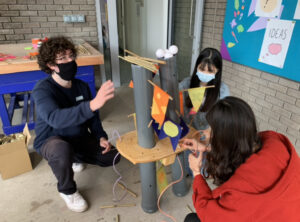



Blue Basho has been holding an ‘Artist’s Toolkit’ workshop at ESW on Thursday morning, 7 October, with artists Debjani Banerjee and Naomi Garriock guiding us through the activities. As it will help you to understand your own art workshop design from an experiential and performance perspective. I will witness and experience what works and what doesn’t work in different learning environments and understand how different learners respond to artistic and educational stimuli. Although I have never participated in a similar art workshop experience before, I have seen how experiencers accomplish tasks in different learning environments. We took part in three themes from the artists’ toolkit (creating installation art in a storytelling context, Prompt Library, and creating container paintings). I confidently told both artists that I wanted to try and do it.
When the artists, Debjani Banerjee and Naomi Garriock, finished presenting the three themes, I was actually a bit confused. I first came across the concept ‘Artist’s Toolkit’ and I felt uneasy because I didn’t know how to experience the three art themes. I really tried to hold back my reaction because my natural reaction would have been to ask my classmates what it was immediately? How to experience it? How to complete it? And what the end result would be? But I held back and managed to work it out. Firstly, I asked the artist carefully about the definition and guidelines of the ‘Artist’s Toolkit’ and the ways in which a particular goal could be accomplished. The artist then explained the toolkit to me by laying out an action plan, explaining the subject matter at hand and giving me a set of suggestions to follow. Secondly, I recalled our previous art classes and how I had prepared ‘art kits’ for my students, combining your education pack or kit according to the different topics. This really gave me the confidence to work through different teaching environments, what was useful and what was not, and to understand how different learners respond to art and education.
The first project was to follow the story context > questions > instructions > ideas to complete a piece of installation art. I think the main reason the whole creative process was good was that our team used the Peeragogy Handbook as a guide to complete, Rheingold (2015) writes that peeragogy is a flexible framework of techniques for peer Whereas pedagogy deals with the transmission of knowledge from teachers to students, peeragogy is what people I have experience of collaborative work in art education activities and I have made some suggestions to them, with the three members contributing their abilities, sharing and collaborating to complete the installation. In addition, the peer collaboration made me think about what kind of abilities are suitable to do what kind of work. In the process of creating the artwork, we needed to discuss each other’s strengths and weaknesses. In addition, the collaborative format of the course was valuable as each member of the group had the opportunity to learn something new and I have no regrets about the process.
The second project was a prompt library activity and I found that I now knew that I could remain calm in such an art education format to complete the experiential task of smelling, touching and listening to an unknown object while our eyes were blindfolded. Although, I would worry that I would not be able to complete the course objectives and the group would always prompt and encourage me, which made me very capable.
I think there are three things I can learn from the experience. On the one hand, I can use this ‘artist’s kit’ as an example of something I can do that I am not sure of, which will give me confidence in my new art education space. For example, encouraging imagination, a collaboration of different backgrounds or abilities, play and experimentation. Secondly, the guidance in the Peeragogy Handbook gave me time to think about the purpose of the curriculum design for each art pack before I acted on it. Finally, the Artist’s Tool contains strategies, methods, lessons, units and tools that provide a play-based approach to learning and teaching and encourage better continuity and progression for all people in all settings.


Leave a Reply